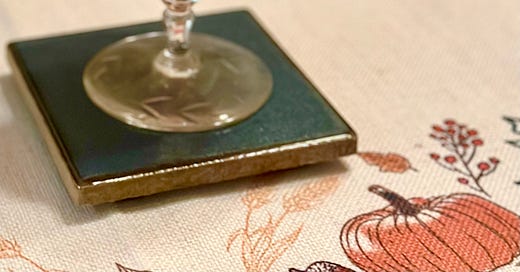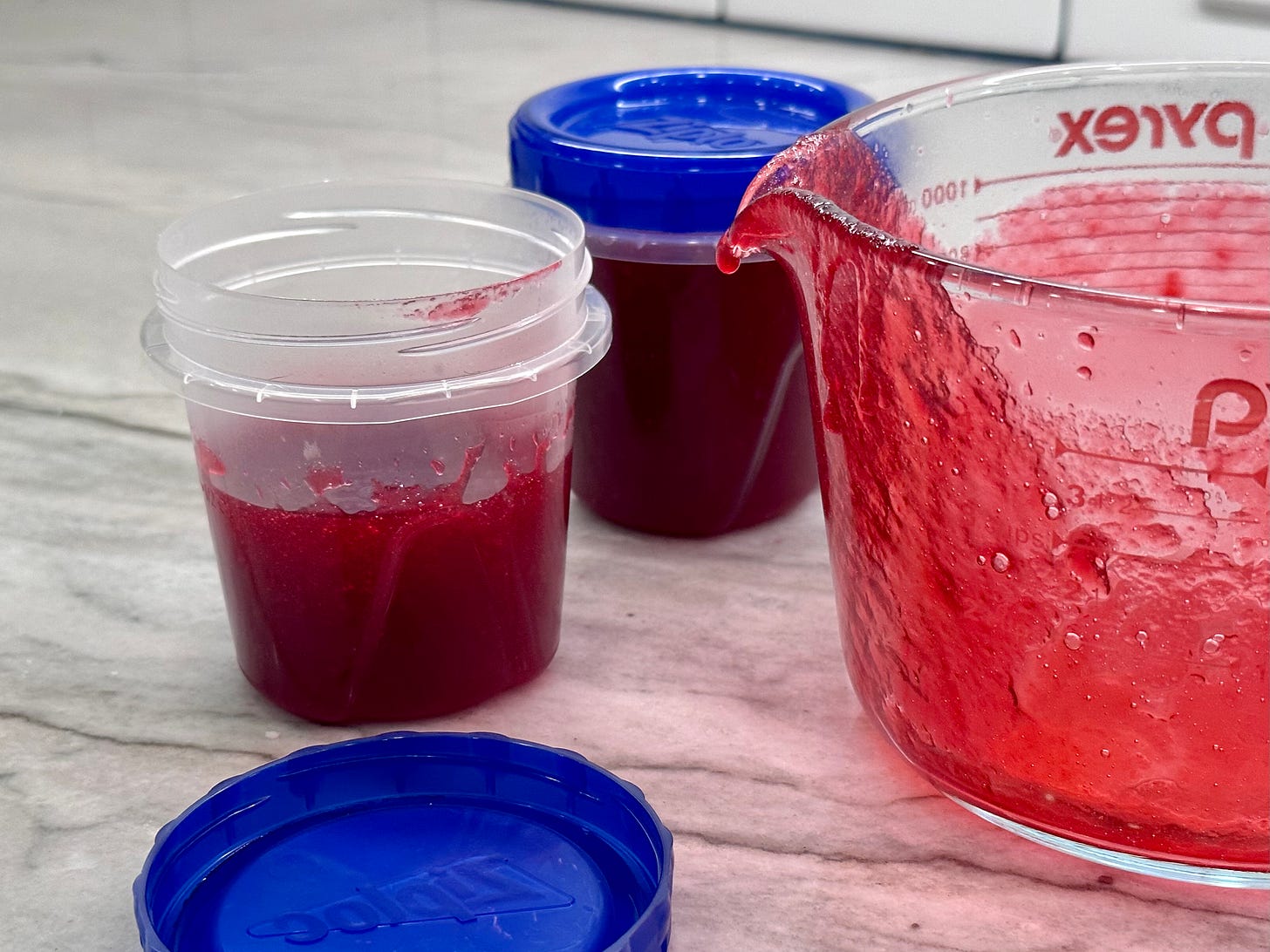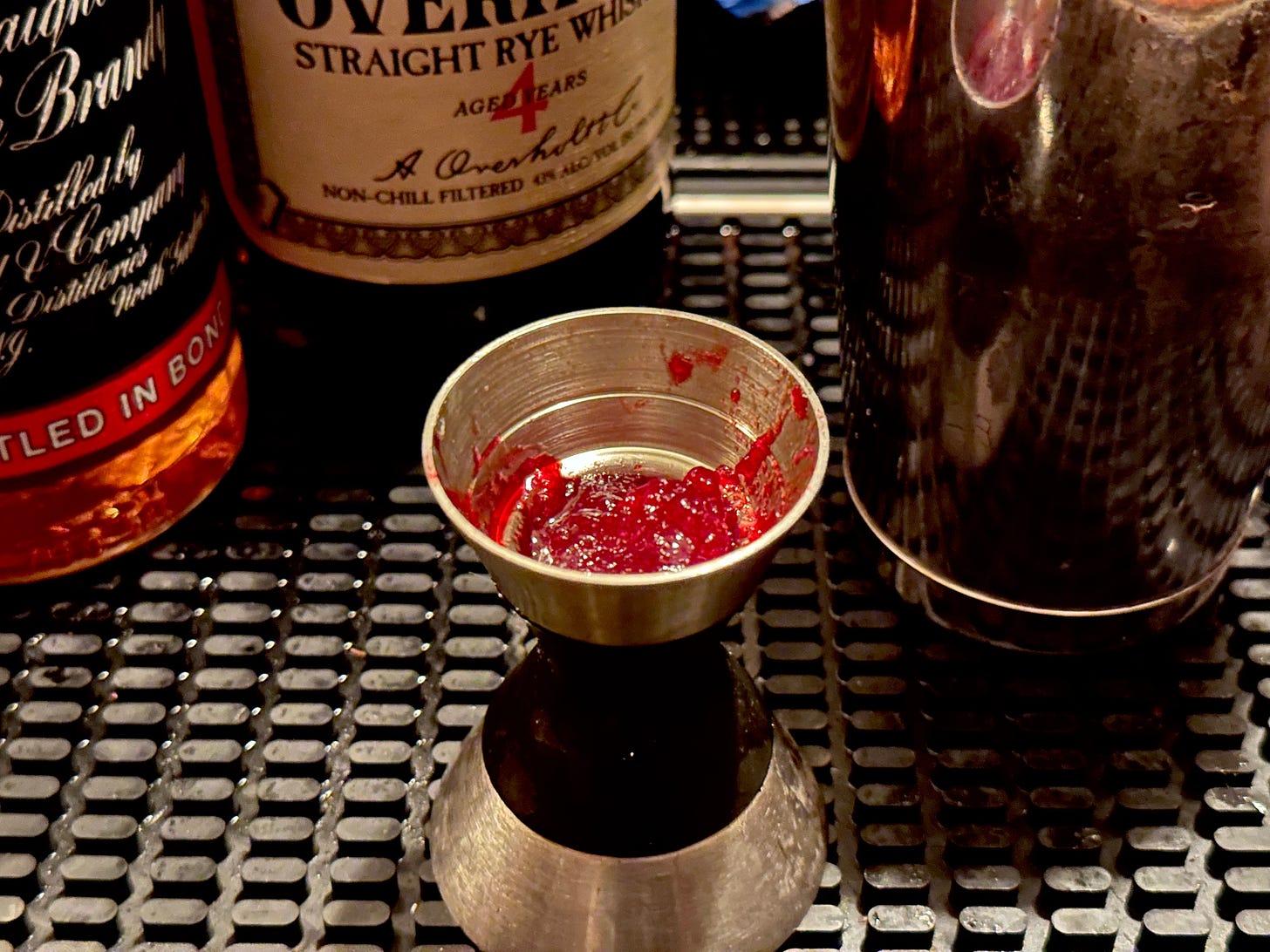A Thanksgiving Sidecar With Jellied Cranberry Sauce, Maple Syrup, Apple Brandy, Whiskey, and Pumpkin Spice Sugar
Happy Turkey Day, folks!
In previous years, this newsletter has always featured a Thanksgiving cocktail:
First, there was the Thanksgiving Sour, a basic brandy sour made holiday friendly by an infusion of apple, cinnamon, and other spices.
There there was the Pumpkin Spice Old Fashioned, an Old Fashioned variation given holiday cheer with a custom pumpkin spice syrup.
Last year, we made a pair of drinks — an Old Fashioned and a rich, eggy flip-style drink — that tasted like pecan pie.
This year we’re going to take another familiar Thanksgiving table foodstuff — cranberry sauce — and build a drink around it. That’s right. We’re going to put cranberry sauce in a cocktail. And it’s going to be easy, fun, and tasty.
The inspiration for this drink started at my own Thanksgiving dinner table. Like so many Americans, my wife makes cranberry sauce for Thanksgiving each year.
If you’ve been to an American Thanksgiving, you’ve probably had some version of this yourself: It’s a bowl of sugary, tangy, gently spicy cranberries cooked in syrup until soft. In its most simplest form, that’s really all it is — sugar, water, and cranberries, heated together for a little while on the stovetop.
In my wife’s version, however, there are a number of spices involved — cinnamon, allspice, the usual assortment of fall holiday flavors. She cooks the cranberries in orange juice as well as water. And at some point during the process, she usually asks me for a bottle of liquor. Whereupon there is a discussion: What sort of liquor should go with cranberries, sugar, and spices?
The answer changes most every year. Some years it’s brandy. Some years it’s an orange liqueur like Cointreau or Grand Marnier (which is itself built on a brandy base). One year we tried rum. Another year we tried rye whiskey.
And no matter what liquor we end up using, it’s always really, really good. The cranberries are spicy, tangy, tart, and sweet in just the right balance. And while the booze mostly cooks off, it imparts just a bit of flavor — pepper and heat from rye, orange-y depth from the Grand Marnier, vanilla richness from the brandy.
And every year, I think: This is rather delightful as cranberry sauce. But what I really want is for this to be a cocktail.
So this year I turned it into a cocktail. Specifically, I turned it into a Sidecar variation with cranberry, maple syrup, apple brandy, and rye whiskey, all of it topped with homemade pumpkin spice sugar.
It’s a Thanksgiving Sidecar, and that’s what we’re going to make today.
Start With a Structure
In last week’s newsletter, I outlined eight essential cocktail structures — basic blueprints for building new cocktails.
This week’s drink is based on number 5, the “Sweet Liqueured Sour.” Most people know this category because it includes the Margarita and the Sidecar. It’s a sour (spirit, lemon or lime, and sweetener) sweetened by a flavored liqueur with some sugar content — most commonly an orange liqueur like Cointreau or Grand Marnier.
I decided to use this category because the Sidecar already includes several of the elements I wanted to incorporate into this drink. A basic Sidecar is just cognac (brandy) shaken with lemon juice and orange liqueur. Many versions also include a sugar rim, but I incorporate a bit of added sugar directly into the drink via a syrup.
My thinking was that I could take the Sidecar format and tweak it to make it taste like a cocktail version of our house cranberry sauce.
The big question was how to get the cranberry element into the drink.
As it happens, the “Sweet Liqueured Sour” category also includes another classic, a 1980s drink known as the Breakfast Martini. The Breakfast Martini is not a Martini as we know it (gin and dry vermouth, stirred). Instead, it’s a gin sour shaken with orange marmalade or jam, which gives it a distinctive flavor and gelatinous texture.
So it’s convenient that if you look at the back of a package of Ocean Spray cranberries, it will provide a very basic recipe for cranberry sauce — just sugar, water, and cranberries heated together, as I noted up top. It also provides a second recipe for jellied cranberry sauce, which is the same thing, but pushed through a fine mesh strainer so that instead of soft but distinct cranberries, everything turns into a gelatinous substance that resembles…yep….marmalade. Or jam.
This was a pretty strong case for a format and a technique. If you could successfully put orange marmalade into your cocktail, then presumably you could do the same with cranberry jelly.
So the first step was to make jellied cranberry sauce.
In this case, I decided against making the more complex spiced version my wife makes for Thanksgiving. I wanted something simple and direct. The other flavors would come from the other cocktail ingredients.
So this is really just a 1:1 stovetop simple syrup with a bunch of cranberries cooked into it, and then the whole thing is strained and mashed into a jelly. It takes 15 minutes tops to make, not including cooling, and almost no effort. And you might even be making something like this for Thanksgiving already.
Cranberry Jelly
1 cup sugar
1 cup water
3 cups cranberries
(You can also make a smaller batch by cutting all the ingredient proportions in half.)
INSTRUCTIONS
Combine sugar and water in a medium saucepan on high heat. Bring to a boil while stirring to combine.
Once the water is boiling (a minute or two), add cranberries. Continue to heat at a low boil. (You may need to adjust the heat down — you want some bubbling, but not so much the saucepan overflows.) Cook sugar, water, and cranberries for about 10 minutes, stirring occasionally.
After about 10 minutes, the cranberries should be very soft, with gloopy jam-like pockets visible. Turn off heat, then strain mixture through a fine mesh strainer or chinois. Push as much of the mixture through the strainer as possible. The result will be thick and, well, jelly like.
Let cool at room temperature, then store in a resealable container in the fridge.
Contra the Flaming Lips, She Does, In Fact, Use Jelly
After making cranberry jelly, the next step was to try to build the drink.
A very simple version of this drink would have just taken the cranberry jelly and added it to a basic Sidecar format in the slot I usually reserve for sugar syrup, like this:
¼ ounce cranberry jelly
¾ ounce Grand Marnier
¾ ounce fresh lemon juice
1 ½ ounce Cognac
Shake all ingredients, strain into a coupe.
But I wanted to bring in a little more depth of flavor. So I started by ditching the Cognac and using a split base of rye and apple brandy, using my go-to bottles of Rittenhouse for the rye and Laird’s bottled-in-bond for the apple brandy.
Why these two? Well, here I drew on some of the ideas and principles I’ve been writing about in this newsletter for many years.
For one thing, as regular readers know, they’re some of my favorites. For another, apple brandy is best as a partner ingredient. It’s a little too light to carry this drink on its own. And rye and apple brandy work incredibly well together.
This was pretty good. But it was a little tangy, since the cranberry jelly is a little more tart than ordinary syrup.
So the next step was to cut back the Grand Marnier slightly and include another sweet element — maple syrup, another fall favorite that works well with all of these ingredients. (You can also use a 2:1 simple syrup here, if you don’t have maple syrup around.)
So now I had a Sidecar with rye, apple brandy, maple syrup, and cranberry jelly.
This was working pretty well…but it was a little bit pushy, just slightly hot and aggressive. And it still lacked all those spice-rack notes I love in my wife’s cranberry sauce.
The lack of spice rack flavors was easy to solve: I dropped in a single dash of Angostura Aromatic bitters, which has notes of clove, cinnamon, and allspice. But this made the drink even more aggressive in a direction I didn’t quite love. Not bad…and even quite tasty in a way — but not quite right either.
And that’s when I realized that I needed to drop the Rittenhouse, which is bold and assertive, for a lighter, fruitier rye: Old Overholt.
These days, Old Overholt is 86 proof and comes with a 4 year age statement on the label. It’s fruity and youthful but adds just enough heft to co-star with the apple brandy, especially with the dash of bitters.
I know this is a fairly specific ingredient request, so I will also say that this drink will certainly work with another quality rye like Rittenhouse, Bulleit, or Sazerac. Don’t feel intimidated if you don’t have this specific bottle!
But moving to a lighter, fruitier expression of rye whiskey made a noticeable difference, and I would encourage you to pick up a bottle of Overholt for this drink. Conveniently, it’s quite inexpensive, at around $20 a bottle, and it’s quite versatile — you’ll be able to use it in many other drinks as well.
Give Me Some (Pumpkin Spice) Sugar
This drink was working pretty well. But it needed one final piece to tie it all together: a garnish of some sort — which, as I wrote earlier this year — should almost always be the final element when designing a drink.
Now, as I noted, the traditional way to dress up a Sidecar is to serve it in a glass with a sugar rim. Typically, I don’t do that. But I thought perhaps in this case a spiced sugar rim — maybe cinnamon sugar? maybe something else? — might work.
I tried this several times, and folks, it really, really did not work.
The cinnamon sugar just clumped around the edge of the glass in ugly, unappealing mud-like blobs. And it didn’t taste very good either. Sometimes I got a big hit of the stuff; sometimes it was missing entirely. It was wet and mushy and stuck to my fingers. Everything about it was unpleasant. Nope!
Still, it seemed like there was a good idea to be found. And then my wife — whose spice-modified cranberry sauce was after all the original inspiration for this drink — had the idea to make a pumpkin pie spice sugar.
This turned out to be very easy to make: Just five parts sugar to one part store-bought pumpkin pie spice (I used McCormick). I just sprinkled it lightly on top, a light dusting — almost like fresh grated nutmeg on the top of eggnog.
For the most even distribution, you can put this mix into a spice shaker, like this one from Oxo. But you can also just sprinkle it gently using a spoon. The point is to create a very fine, very light dusting of pumpkin spice sugar on the top of the drink.
Pumpkin Pie Sugar
1 teaspoon pumpkin pie spice, such as McCormick
5 teaspoons sugar
INSTRUCTIONS
Combine in a bowl.
Mix together with a fork.
With 8 ingredients, including two homemade items (the jelly and the pumpkin pie sugar) the final recipe might look somewhat complicated. And sure, it’s not a basic three-ingredient cocktail that you mix up at 9 p.m. on a Monday after a long day in the content mill.
But it’s really just a very straightforward riff on a Sidecar, with some of the elements swapped out and/or split into multiple components. It’s a demonstration of how those essential structures I wrote about last week can be used not only to create new drinks at semi-random with whatever you have on hand, but to intentionally incorporate flavors thematically and conceptually.
Also, it’s pretty tasty, and with its deep red color, it will look great at your Thanksgiving dinner table. Happy Turkey Day, folks.
Thanksgiving Sidecar
1 dash Angostura Aromatic bitters
¼ ounce cranberry jelly
¼ ounce maple syrup
½ ounce Grand Marnier
¾ ounce lemon juice
¾ ounce rye, preferably Old Overholt
¾ ounce Laird’s Straight Apple Brandy bottled-in-bond
Pumpkin pie sugar, to sprinkle on top
INSTRUCTIONS
Combine all ingredients except the pumpkin pie sugar in a cocktail shaker.
Add ice, then shake until thoroughly chilled, about 10-15 seconds.
Strain into a coupe glass.
Sprinkle pumpkin pie sugar on top.
Substitutions, Swaps, and How to Measure Out that Cranberry Jelly
Although I specify very particular bottles of rye and apple brandy here, you should feel free to use any bottle of rye and any bottle of apple brandy, applejack, or calvados (French apple brandy) in those slots. Frankly, you could probably play around with the rum-rye-brandy triangle and get some good results.
Admittedly it’s kind of pain to measure the cranberry jelly — but I just use a barspoon to grab a small hunk of it and then stuff it into a jigger like pictured below, then use the same spoon to scrape it back out. It’s not perfectly precise, but it’s close enough.
You may have a little bit of solid jelly left in your shaker after shaking and straining. That’s fine! You’ll still taste the cranberry accent in your drink. Just make sure to give your shaker a good rinse before making another drink.
The Pumpkin Pie Sugar top is nice and fun, but also optional. Don’t feel like you can’t make this drink if you don’t have a jar of pumpkin pie spice around. Make what you can with what you have!
I am tempted to work up a Cynar-adapted version of this drink, but for holiday cocktails, I like to keep things pretty accessible, taste wise. If some intrepid reader wants to Cynar-ify this drink, I’d love to hear about it.







Peter! What about the (purple) elephant in the room? Using canned cranberry sauce!?!
Very nice! It is fun to make a special cocktail to share with family for the holiday. A note on measuring the cranberry jelly... I just converted the 1/4 oz to teaspoons and measured it with regular measuring spoons rather than a jigger. 1/4 oz = 1-1/2 teaspoons.